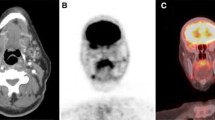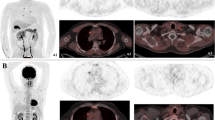Abstract
We investigated 5 MTC patients, 3 preoperatively for staging purpose, and 2 after surgery, during the follow-up, because of the persistence of elevated serum tumoral markers. FDG PET results were compared with conventional radiologic (US, CT scan, MRI) and scintigraphic non-invasive techniques (99mTc-MIBI and 99mTc-MDP scans). In all the 3 patients preoperatively studied, PET, as well as the other imaging modalities, detected the primitive tumor and the loco-regional lymphnode metastases. Furthermore, in one case, PET was the only technique that revealed an additional localization to the lungs. One false negative result was recorded with PET, as well as with the conventional imaging, in a MTC patient with a MEN II syndrome and with some liver micrometastases, 2 to 5 mm sized, showed only at laparotomy. PET was the only method capable of early visualizing a mediastinal relapse of the tumor in one of the 2 patients studied during the follow-up. This patient was re-operated and serum calcitonin levels became undetectable. On the basis of our preliminary results on MTC, PET with FDG seems to be an accurate, non-invasive technique, for staging purpose before surgery, and, during the follow-up for visualizing tumoral spread in patients with increased serum tumoral markers.
Similar content being viewed by others
References
Brunt L.M., Wells S. Advances in the diagnosis and treatment of medullary thyroid carcinoma. Surg. Clin. North. Am. 67: 263, 1987.
Mazzaferri E.L. Papillary thyroid carcinoma: factors influencing prognosis and current therapy. Sem. Oncol. 14: 315, 1988.
DeGroot L.J., Kaplan E.L., McCormik M., Strauss F. Natural history, treatment, and course of papillary thyroid carcinoma. J. Clin. Endocrinol. Metab. 71: 414, 1990.
Kallinowskii F., Buhr H.J., Meybier H., Eberhardt M., Herforth C. Medullary carcinoma of the thyroid — therapeutic strategy derived from fifteen years of experience. Surgery 114: 491, 1993.
DeBesi P., Busnardo B., Toso S., Girelli M.E., Simioni N., Casara D., Zorat P.L., Fiorentino M.L. BAP (Bleomycin, Doxorubicin and Cisplatin) regimen in advanced thyroid carcinoma. J. Endocrinol. Invest. 14: 475, 1991.
Nguyen T.D., Chessard J.L., Lagarde P., Cutuli B., Le Fur R., Reme-Saumon M., Prevost B., Panis X., Verrelle P., Chaplin G. Results of postoperative radiation therapy in medullary carcinoma of the thyroid: a retrospective study by the French Federation of the Cancer Institutes. The radiotherapy cooperative group. Radioth. Oncol. 23: 1, 1992.
Guerra U., Pizzocaro C., Terzi A., Giubbini R., Bestagno M. The use of 99mTc(V)DMSA as imaging for the medullary thyroid carcinoma (MTC). J. Nucl. Med. Allied Sci. 32: 242, 1988.
Ugur O., Kostakoglu L., Guler N., Coner B., Uysal U., Elahi N., Haliliglu M., Yuksal D., Aras T., Bayhen H., Bekdik C. Comparison of 99mTc(V)-DMSA, 201 Tl and 99mTc-MIBI imaging in the follow-up of patients with medullary carcinoma of the thyroid. Eur. J. Nucl. Med. 23: 1367, 1996.
Lebouthillier G., Morais J., Picard M., Picard D., Chartrand R., D’Amom P. Tc99m-sestamibi and other agents in the detection of medullary carcinoma of the thyroid. Clin. Nucl. Med. 18: 657, 1993.
Baudin E., Lumbroso J., Schlumberger M., Leclere J., Giammorile F., Gardet P., Roche A., Travagli J.P., Parmenter C. Comparison of octreotide scintigraphy and conventional imaging in medullary thyroid carcinoma. J. Nucl. Med. 32: 912, 1996.
Manil L., Boudet F., Matte P., Gardet P., Saccavini J.C., Lumbroso J.D., Schlumberger M., Caillou B., Bazin J.P., Ricard M., Bellet D., Bohnon C., Tubiana M., Di Paola R., Parmentier C. Positive anticalcitonin immunoscintigraphy in patients with medullary thyroid carcinoma. Cancer Res. 49: 548, 1989.
Zanin D.E.A., van Dongen A., Hoefnagel C.A., Bruning P.F. Radioimmunoscintigraphy using iodine-131-anti-CEA monoclonal antibodies and Thallium-201 scintigraphy in medullary thyroid carcinoma: a case report. J. Nucl. Med. 31: 1854, 1990.
Endo K., Shiomi K., Kasagi K. Imaging of the medullary thyroid cancer with 131I-MIBG. Lancet 2: 233, 1984.
Abdel-Dayen H.M., Scott A.M., Mecapiulac H.A., El-Gazzar A.A.H., Larson S.M. Role of 201TI chloride and 99mTc-sestamibi in tumor imaging. In: Freeman L.M. (Ed.), Nuclear Medicine Annual. Raven Press, New York, 1994, p. 181.
Casara D., Saladini G., Rubello D., Borsato N., Ferlin G. Scintigraphic localization of recurrent medullary and differentiated thyroid carcinoma with 99mTc-MIBI. J. Nucl. Biol. Med. 38: 166, 1994.
Goldemberg D.M. Monoclonal antibodies in cancer detection and therapy. Am. J. Med. 94: 297, 1993.
Juweid M., Sharkey R.M., Behr T. Improved detection of medullary thyroid cancer with radiolabeled monoclonal antibodies to carcinoembryonic antigen. J. Clin. Oncol. 14: 1209, 1996.
Strauss L.G., Conti P.S. The application of PET in clinical oncology. J. Nucl. Med. 32: 623, 1991.
Gupta N.C., Maloof J., Gunel E. Probability of malignancy in solitary pulmonary nodules using Fluorine-18-FDG. J. Nucl. Med. 37: 943, 1996.
Feine U., Lietzemmayer R., Hanke J.P., Held J., Wohrle H., Muller-Schauenburg W. Fuorine-1 8-FDG and iodine-131 Iodine uptake in thyroid cancer. J. Nucl. Med. 37: 1472, 1996.
Author information
Authors and Affiliations
Rights and permissions
About this article
Cite this article
Gasparoni, P., Rubello, D. & Ferlin, G. Potential role of fluorine-18-deoxyglucose (FDG) positron emission tomography (PET) in the staging of primitive and recurrent medullary thyroid carcinoma. J Endocrinol Invest 20, 527–530 (1997). https://doi.org/10.1007/BF03348014
Accepted:
Published:
Issue Date:
DOI: https://doi.org/10.1007/BF03348014




